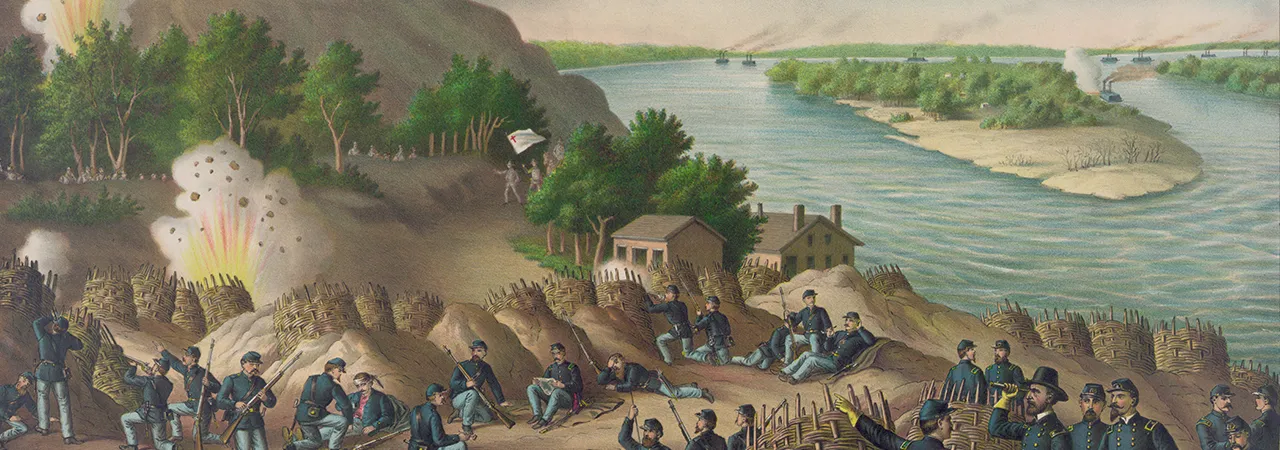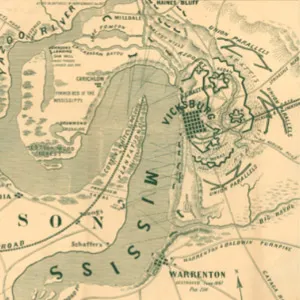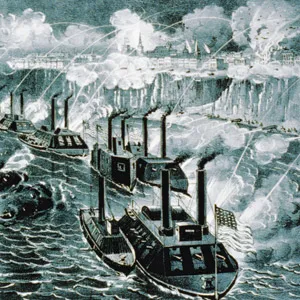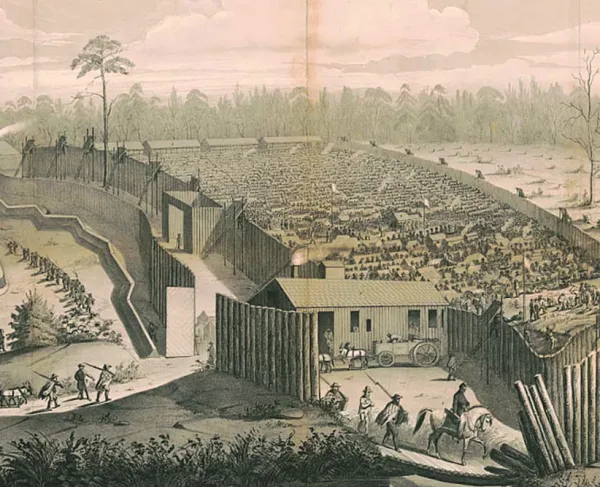
Those setting out to study the Vicksburg Campaign will immediately find themselves immersed in a fascinating cross-section of strategy and technology, both ancient and modern. Use this annotated glossary to enhance your exploration of this continent-altering campaign.
Siege
“Siege” is the name for a specific set of military circumstances, but the term is often misapplied. For a siege to be in place, the defending force must be completely encircled by the aggressing force and completely cut off from external sources of supply. This produces a situation in which the defenders must starve, surrender or break through the enemy’s line.
Assaulting a fortified city will typically result in heavy losses. By besieging a city, its defenders are forced to make the same kind of assaults against fortified siege lines in order to break out. Else they must yield to inevitable starvation and capitulation.
Vicksburg was, in fact, besieged. The Union army and navy blocked all entrances to and exits from the city. The “Siege” of Petersburg, on the other hand, is misnamed. The northwestern face of that Virginia city was left unguarded by Union forces, giving the Confederates an avenue of supply and possible retreat throughout the campaign. Confederate Gen. Robert E. Lee was reluctant to abandon Petersburg, but he was not trapped there.

Unconditional Surrender
In February 1862, Ulysses S. Grant earned the nickname “Unconditional Surrender” after forcing the capitulation of Fort Donelson with a dispatch that read, in part, “No terms except an unconditional and immediate surrender can be accepted. I propose to move immediately upon your works.”
An unconditional surrender is one in which the victors make no guarantees to their vanquished foes regarding their future treatment. Although Grant demanded another unconditional surrender at Vicksburg, the Confederates refused to accept such an absence of terms. The two sides eventually agreed to a relatively generous settlement that allowed most of the defenders to rejoin the Confederate army by the end of August.
In most cases, a demand of unconditional surrender is merely a negotiating tactic, a strong opening meant to compel an advantageous compromise. During World War II, however, Franklin Roosevelt began to call for an unconditional surrender of the Axis nations as early as January 1943. While this object was ultimately achieved, the timing of the demand upset Winston Churchill and Joseph Stalin, who thought it would harden Axis opposition.
Gunboat
Civil War gunboats navigated in shallow waters, such as rivers and coastlines. Ideally, they mounted the arms and armor necessary to contend with other gunboats as well as land-based fortifications.
While both sides purpose-built gunboats throughout the war, both also converted a number of civilian craft to military use on the Mississippi River. With military production shifting toward ironclad gunboats, many of the converted craft were derisively called “tinclads” or “cottonclads.”

Redans
A redan is a V-shaped protrusion in a fortified line, with the tip of the V oriented toward the enemy. Military doctrine states that every part of a defensive position should be flanked by another part of the position. This allows the defenders to increase their firepower at the threatened point, enhance the psychological effect of that firepower and maintain some level of resistance even if one position is knocked out.
Redans serve this purpose, although they are themselves open to attack from two sides and thus more likely to be targeted in an assault.

Approaches and Parallels
The Union ring around Vicksburg was drawn tight through the construction of “approaches” and “parallels” — a system of entrenchments that allowed Union soldiers to close in on the fortress with minimal risk.
During a siege, all-out assaults are especially costly, typically requiring a long advance over cleared ground before striking the enemy’s fortifications. To address this problem at Vicksburg, Grant ordered his soldiers to dig zig-zagging trenches (approaches) toward the city. The zig-zag design prevented Confederate soldiers from firing down the length of the approaches.
Once the diagonal approaches had gotten close enough, the Federals reverted to “parallels,” trenches that once again ran parallel to the Confederate line. From the parallels, new assaults could be launched, in which the attacking soldiers would have less time to spend in open ground.

Combined Arms
“Combined arms” is the military concept of harmonizing disparate weapons and equipment to multiply their effect on the battlefield. Such harmony can be difficult to achieve, however, as it typically requires close cooperation between different branches of the military, as well as a plan that makes optimum use of the various weapons involved.
At Vicksburg, “combined arms” referred to the cooperation of the Union army and navy to effect the capitulation of the city. The movement ability and heavy firepower of the gunboats was used to multiply the ground-taking capability of the infantry. Infantry surrounded the city on three sides while gunboats held the fourth side from the river. In the words of naval commander David D. Porter, “Ships cannot crawl up hills 300 feet high, and it is that part of Vicksburg which must be taken by the Army.”
All images from Library of Congress
Related Battles
4,910
32,363





